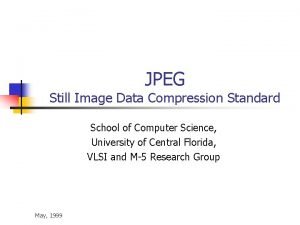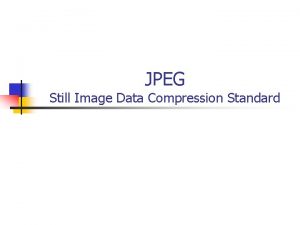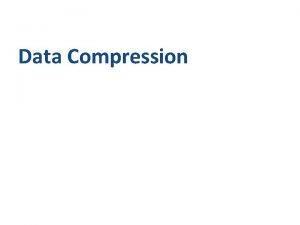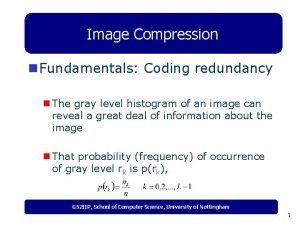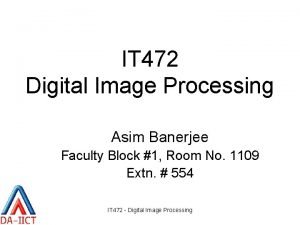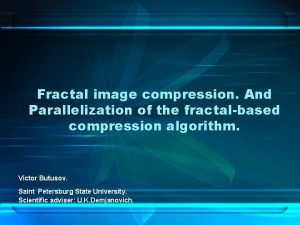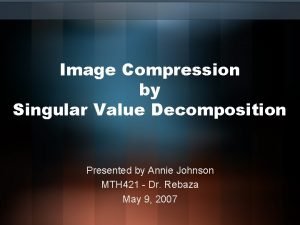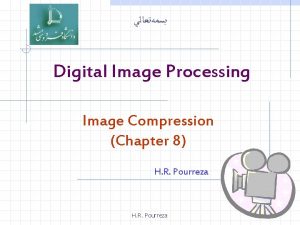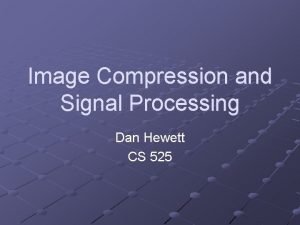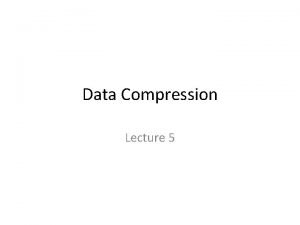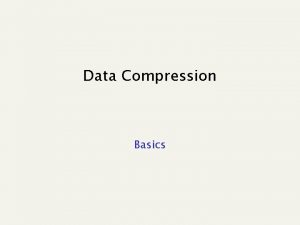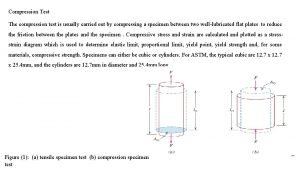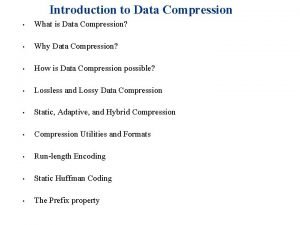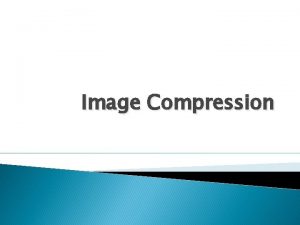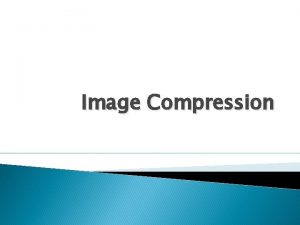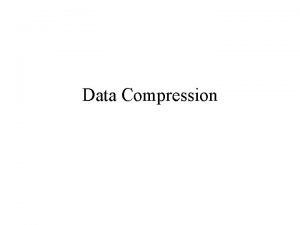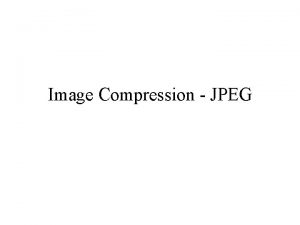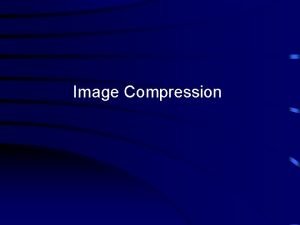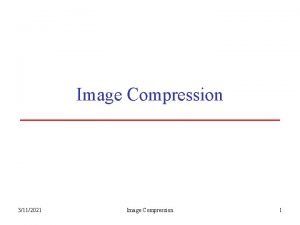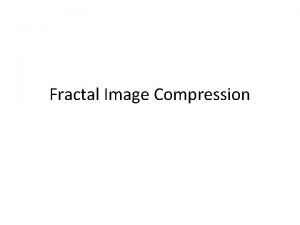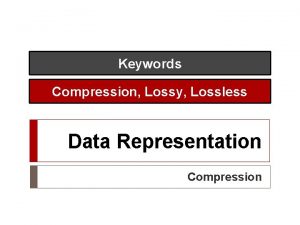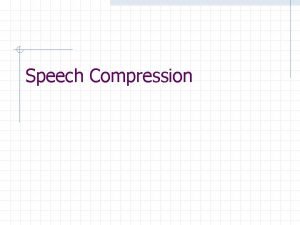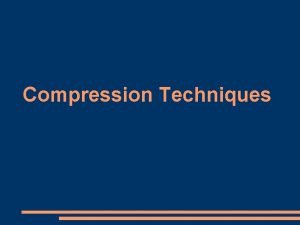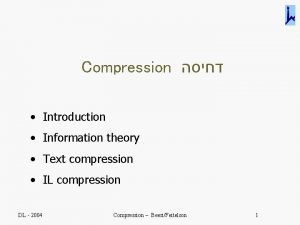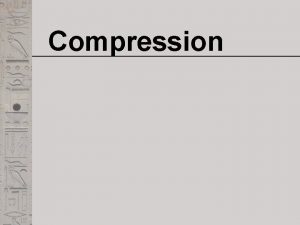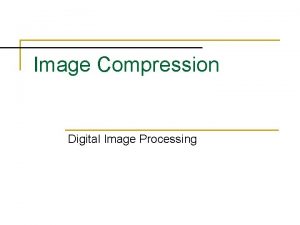Data Compression What is an image Why Data



















- Slides: 19

Data Compression

What is an image?

Why Data Compression? • Make optimal use of limited storage space • Save time and help to optimize resources § If compression and decompression are done in I/O processor, less time is required to move data to or from storage subsystem, freeing I/O bus for other work § In sending data over communication line: less time to transmit and less storage to host OR § Reduce the memory required for storage § Improve the data access rate from storage device and § Reduce the bandwidth and/or the time required for transfer across communication channels.

Image Redundancies Redundancy refers to the amount of wasted space consumed by storage media to record picture information in a digital image. Image compression is achieved by exploiting redundancies in the image. These redundancies could be spatial, spectral, or temporal redundancy. Spatial redundancy: elements that are duplicated within a structure, such as neighboring pixels in a still image. Exploiting spatial redundancy is how compression is performed. Spectral redundancy is due to correlation between different color planes. Temporal redundancy: pixels in two video frames that have the same values in the same location. It is due to correlation between different frames in a sequence of images such as in videoconferencing applications in broadcast images. Exploiting temporal redundancy is one of the primary techniques in video compression.

Data Compression Methods • Data compression is about storing and sending a smaller number of bits. • There’re two major categories for methods to compress data: lossless and lossy methods

Lossless Compression Methods • In lossless methods, original data and the data after compression and decompression are exactly the same. • Redundant data is removed in compression and added during decompression. • Lossless methods are used when we can’t afford to lose any data: legal and medical documents, computer programs.

Run-length encoding • Simplest method of compression. • How: replace consecutive repeating occurrences of a symbol by 1 occurrence of the symbol itself, then followed by the number of occurrences. • The method can be more efficient if the data uses only 2 symbols (0 s and 1 s) in bit patterns and 1 symbol is more frequent than another.

Huffman Coding Assign fewer bits to symbols that occur more frequently and more bits to symbols appear less often. There’s no unique Huffman code and every Huffman code has the same average code length. Algorithm: 1. 2. 3. Make a leaf node for each code symbol Add the generation probability of each symbol to the leaf node Take the two leaf nodes with the smallest probability and connect them into a new node Add 1 or 0 to each of the two branches The probability of the new node is the sum of the probabilities of the two connecting nodes If there is only one node left, the code construction is completed. If not, go back to (2)

Huffman Coding • Example

Huffman Coding • Encoding • Decoding

Lossy Compression Methods • Used for compressing images and video files (our eyes cannot distinguish subtle changes, so lossy data is acceptable). • These methods are cheaper, less time and space. • Several methods: § JPEG: compress pictures and graphics § MPEG: compress video § MP 3: compress audio

JPEG Encoding • Used to compress pictures and graphics. • In JPEG, a grayscale picture is divided into 8 x 8 pixel blocks to decrease the number of calculations. • Basic idea: § Change the picture into a linear (vector) sets of numbers that reveals the redundancies. § The redundancies is then removed by one of lossless compression methods.

JPEG Encoding- DCT • DCT: Discrete Concise Transform • DCT transforms the 64 values in 8 x 8 pixel block in a way that the relative relationships between pixels are kept but the redundancies are revealed. • Example: A gradient grayscale

Quantization & Compression Quantization § After T table is created, the values are quantized to reduce the number of bits needed for encoding. § Quantization divides the number of bits by a constant, then drops the fraction. This is done to optimize the number of bits and the number of 0 s for each particular application. Compression § Quantized values are read from the table and redundant 0 s are removed. § To cluster the 0 s together, the table is read diagonally in an zigzag fashion. The reason is if the table doesn’t have fine changes, the bottom right corner of the table is all 0 s. § JPEG usually uses lossless run-length encoding at the compression phase.

JPEG Encoding

MPEG Encoding • Used to compress video. • Basic idea: § Each video is a rapid sequence of a set of frames. Each frame is a spatial combination of pixels, or a picture. § Compressing video = spatially compressing each frame + temporally compressing a set of frames.

MPEG Encoding • Spatial Compression § Each frame is spatially compressed by JPEG. • Temporal Compression § Redundant frames are removed. § For example, in a static scene in which someone is talking, most frames are the same except for the segment around the speaker’s lips, which changes from one frame to the next.

Audio Compression • Used for speech or music § Speech: compress a 64 k. Hz digitized signal § Music: compress a 1. 411 MHz signal • Two categories of techniques: § Predictive encoding § Perceptual encoding

Audio Encoding Predictive Encoding § Only the differences between samples are encoded, not the whole sample values. § Several standards: GSM (13 kbps), G. 729 (8 kbps), and G. 723. 3 (6. 4 or 5. 3 kbps) Perceptual Encoding: MP 3 § CD-quality audio needs at least 1. 411 Mbps and cannot be sent over the Internet without compression. § MP 3 (MPEG audio layer 3) uses perceptual encoding technique to compress audio.
 Spatial and temporal redundancy in digital image processing
Spatial and temporal redundancy in digital image processing Image compression model in digital image processing
Image compression model in digital image processing Why why why why
Why why why why Jpeg: still image data compression standard
Jpeg: still image data compression standard Jpeg still image data compression standard
Jpeg still image data compression standard Image compression
Image compression Psychovisual redundancy
Psychovisual redundancy Lossless compression in digital image processing
Lossless compression in digital image processing Yuvpak compressed fractal image
Yuvpak compressed fractal image Singular value decomposition image compression
Singular value decomposition image compression Jpeg in digital image processing
Jpeg in digital image processing Signal image compression
Signal image compression Data compression in data mining
Data compression in data mining Don't ask why why why
Don't ask why why why What is lossy data compression
What is lossy data compression Adaptive huffman coding
Adaptive huffman coding Uniquely decodable code in data compression
Uniquely decodable code in data compression Merrval
Merrval Compression test is carried on which material
Compression test is carried on which material What is
What is



